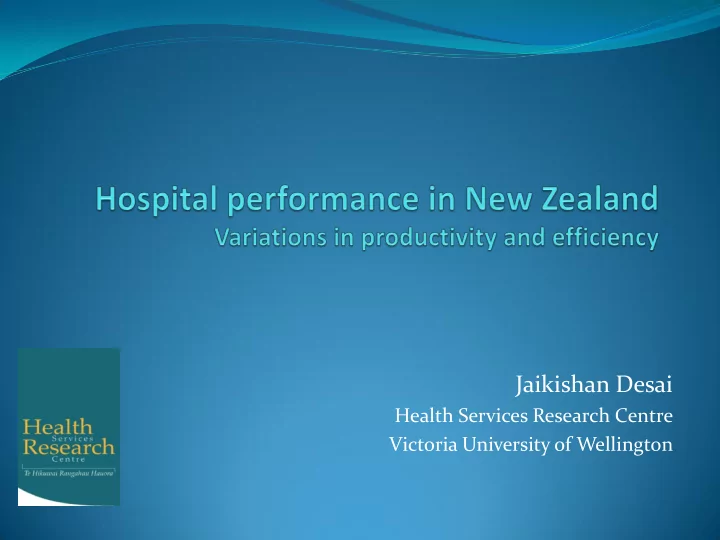

Jaikishan Desai Health Services Research Centre Victoria University of Wellington
Productivity and efficiency of hospitals in NZ Conceptually Measurement(ally) Realistically
Productivity - Conceptually Technically Ratio of outputs to inputs Multiple outputs, multiple inputs So Output Index/Input Index Plain language Amount of hospital services (output) produced with one unit of inputs Measurement Combining multiple outputs & multiple inputs into single indices (for ratio)
Efficiency - Conceptually Technically Technical efficiency – best combination of resources (inputs) to produce each output Allocative efficiency – lowest cost combination of resources (inputs) to produce given outputs (in NZ context) Plain language How efficiently are resources used to produce hospital services Measurement Data envelopment analysis, Malmquist indices, stochastic frontier analysis
Measurement - Productivity Productivity index Pi it Productivity Index it = Output Index it / Input Index it i = hospital (or DHB), t = time period (month, quarter, year) Output Index it = j ∑ q ijt w j j = treatment types q ijt treatments of type j provided by hospital i at time t w j (constant) weight for treatment type j (DRG) Input Index = k ∑ x ikt w kt xikt resource k used in hospital i at time t w kt weight (price) of resource k at time t
Measurement – Outputs & Inputs Outputs - follow the flow Day patient discharges Length of stay Inpatient discharges Stats NZ & MoH weights IP – casemix adj. 85.5%; ALOS (7.5%); DP (7%) Inputs Labor – FTE by type Capital - ?? Consumables (intermediate consumption)
Productivity - Realistically DATA Output - DETAILED National Minimum Data Set (NMDS) + Others Discharges from all public (and private) hospitals Y ijt - individual i discharged from hospital j at time t j = 1 to 91, t = dates from 2001 to 2009 Y i - discharges differ by.. Individual characteristics (age, sex, deprivation, etc.) Cause of admission (ICD-9, 10) Factors reflecting hospital experience – length of stay, mortality, post-OP sepsis, etc. Input data - LIMITED Limited temporal dimension Bed capacity of hospital j (derived from NMDS ) FTE (HWIP) – at best quarterly Linked Employer-Employee Dataset (LEED) – for labor counts Household Labour Force Survey (HLFS) Census
Productivity – Possibilities Limited input data Quarterly FTE + financial reports + bed capacity – available sources At best quarterly productivity indices More suited for temporal comparison than spatial differences Funding cycle’s implications for resource allocation Hard & soft constraints – what interpretational value? Does within-financial year variation reveal anything about resource allocation differences?
Output Indicators - LOS Mean length of stay 3 2.9 2.8 2.7 2.6 2.5 2.4 2.3 2.2 2001-02 2002-03 2003-04 2004-05 2005-06 2006-07 2007-08 2008-09
Output Indicators – Day Cases Proportion of day cases 0.34 0.33 0.32 0.31 0.3 0.29 0.28 0.27 2001-02 2002-03 2003-04 2004-05 2005-06 2006-07 2007-08 2008-09
Variation within a year - LOS % times month has highest LOS in financial year 18 16 14 12 10 8 6 4 2 0 Jan Feb Mar Apr May Jun Jul Aug Sep Oct Nov Dec
Variation within a year - Daycases % times month has highest Daycases in financial year 18 16 14 12 10 8 6 4 2 0 Jan Feb Mar Apr May Jun Jul Aug Sep Oct Nov Dec
Road ahead Quarterly productivity indices Output index Case-mix adjustment (DRG weights?) Combining output indicators: day cases, EDs, length of stay, inpatient stays (#) using fixed weights Quarterly (at best) Input index Bed capacity – based on NMDS (concurrent stays) FTEs – quarterly from HWIP Quality adjustment Possibly using Principal components – to combine Patient Safety indicators
Variation in productivity Multi-level modelling (MLM) of variation in quarterly productivity indices Controlling for client population characteristics Primary focus Temporal variation Spatial differences (across DHBs) Functional form Discharge-level analysis with MLM more n, lower standard errors Hospital-level smaller n, more conservative standard errors
Recommend
More recommend